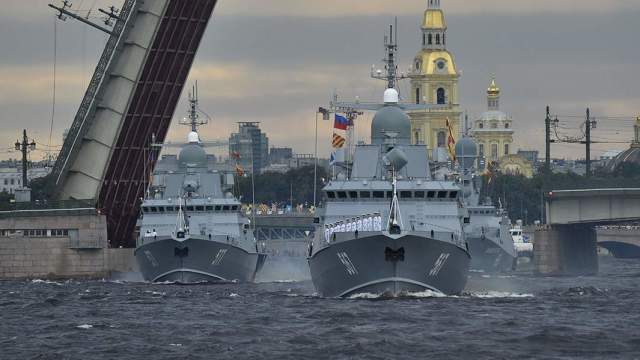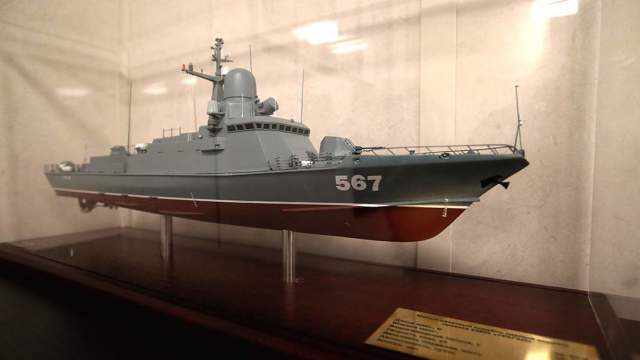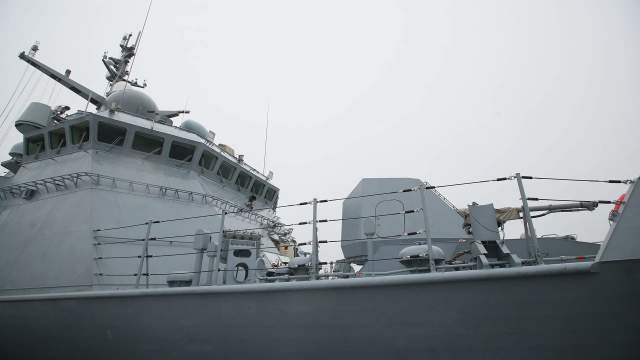To do this, the MRK "Mytishchi" successfully passed into the White Sea via inland waterwaysRussian small rocket ships (MRCS) will be able to move quickly between the Baltic and the northern Seas.
MRK "Mytishchi" of project 22800 "Karakurt" successfully completed the transfer from the Baltic to the White Sea and back by inland waterways. Such maneuvers between fleets are of great importance - ships do not have to go around the Scandinavian Peninsula and pass through the waters controlled by NATO countries. Experts note that such trainings are especially relevant against the background of the strengthening of the North Atlantic Alliance grouping in the region.
Tested by the North
The small rocket ship "Mytishchi" made the transition from the Baltic to the White Sea. There he conducted a full cycle of training missile firing from onboard weapons and is now returning back, sources told Izvestia in the military department. His path passed through the White Sea-Baltic Canal, Lake Ladoga and the Neva. After that, Mytishchi will enter Kronstadt to replenish supplies. The total distance that the MRC will travel in this campaign will exceed three thousand nautical miles. According to sources, the possibility of such maneuvers between fleets will allow to respond quickly to threats in one direction or another.
Such a passage of large warships on inland waterways is considered very difficult and requires highly qualified crew. In cramped river conditions, it is necessary to cope with strong currents, as well as to pass dozens of locks.

MRK project 22800 "Mytishchi" and "Sovetsk"
Image source: Photo: IZVESTIA/Alexander Polegenko
The ships of project 22800 should become the most massive project of attack ships for our fleet. To date, the Russian Navy has three representatives of the series - "Mytishchi", "Sovetsk" and "Odintsovo". They are part of the 6th Order of the Red Banner of Nakhimov I degree brigade of missile boats of the Baltic Fleet. In total, it is planned to build 18 "Karakurts". They are simultaneously produced at the shipyards of St. Petersburg, Zelenodolsk, Crimea and the Far East. It is assumed that by the mid-2020s, the Baltic, Black Sea and Pacific fleets will each have their own compound of "Karakurts".
The passage of inland waterways was practiced by ships in Soviet times, including even submarines, Admiral Valentin Selivanov, ex-chief of the General Staff of the Navy, told Izvestia.
- This is very important. After all, a small rocket ship does not work in the ocean — it should not be allowed there to maneuver to the Northern Fleet or from there to the Baltic," the admiral told Izvestia. - And by internal ways - there are no questions, he calmly passes. This channel is of great importance. There will be no need to send ships through the Danish Straits, through the North Sea. So it turns out faster, and more stealthily, and safer.
According to Valentin Selivanov, today it is not so easy to conduct missile firing in the Baltic waters due to the relatively small size of neutral and Russian territorial waters. Full-fledged combat training of new corvettes with long-range weapons can be conducted only in the North.
- In the current situation, such maneuvers are both logical and profitable. The Karakurts do not have to pass through hostile waters - the Danish Straits, the North Sea. Moreover, a small rocket ship in such a campaign needs to be provided, which means that some kind of tugboat should be nearby. And here it is both profitable and safe," the admiral concluded.
The Russian Baltic Fleet is now facing serious new challenges, so ensuring the mobility of its ships is very important, former Deputy Foreign Minister Sergei Ordzhonikidze said in an interview with Izvestia.
- NATO countries have increased in number, there are more of them. And they have repeatedly stated that the Baltic Sea will be a NATO lake, and the Baltic Fleet will not be able to resist them in any way. But today it is not the quantity of weapons that is important, but its quality," he believes. — MRCS are hardly noticeable to enemy radars, and at the same time have great striking power. They are armed with missiles of this class, which are capable of hitting ships of much larger sizes and ground targets. So these small missile ships play an important role in protecting our interests in the Baltic and in the North-West of Russia as a whole.
The "Karakurt" trail
The Karakurts are relatively small ships with a displacement of 870 tons. However, despite their modest size, they carry a rather impressive arsenal. In particular, the 3S14 firing complex for eight Kalibr cruise missiles or supersonic Onyx anti-ship missiles, as well as the 76.2-millimeter AK-176MA artillery system. Starting with the third ship of the series — Odintsovo — a naval version of the Pantsir-M missile and cannon complex is installed on them, which seriously increases the capabilities of combating air targets and anti-ship missiles.

Layout of the MRC "Mytishchi"
Image source: Photo: IZVESTIA/Alexander Kazakov
Chopped geometric shapes and the use of radio-absorbing materials in the design make the Karakurts less noticeable to enemy radars than previous generations of MRCS. At the same time, they are equipped with modern radar and navigation equipment, as well as combat control, detection, targeting and communication complexes.
Orlan-10 drones with a range of up to 120 km can be based on board the Karakurts. They can be used as scouts or gunners. Drones make "Karakurts" almost invisible. In a combat situation, the crew of the ship can take drones into the sky to assess the environment, and not turn on radars, the signal of which can be detected by enemy radar.
For the first time, the capabilities of the Karakurt MRC project in the Arctic latitudes were tested a year ago. Then the Sovetsk ship worked out the use of weapons, the operation of combat posts, maneuvering and conducting radio exchange in areas of intensive shipping, as well as anti-sabotage defense.
Roman Kretsul
Alexey Ramm

